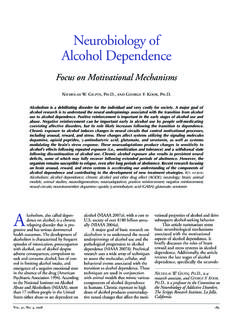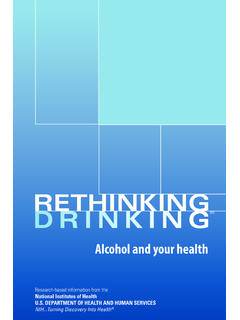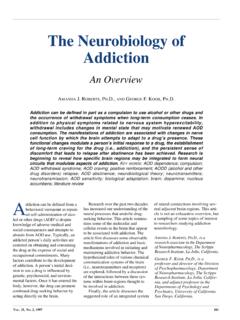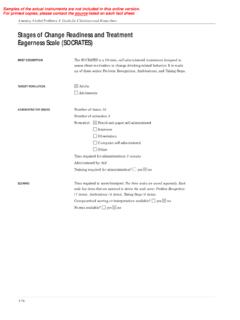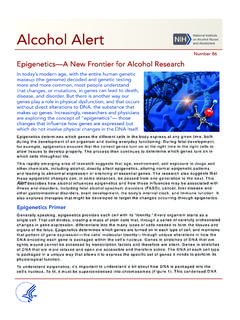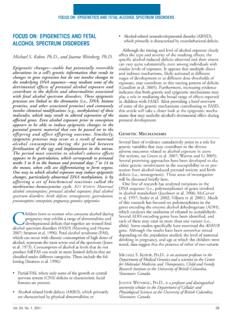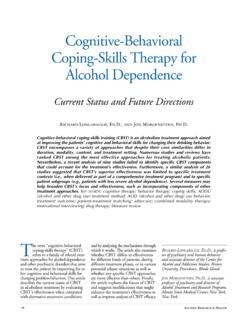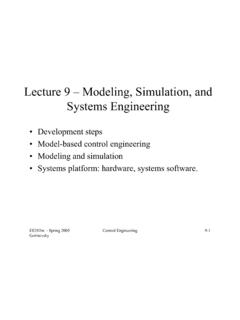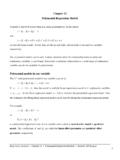Transcription of The Endocrine System - National Institutes of Health
1 Long with the nervous System , the Endocrine , or hormonal, System is the primary regula-tory mechanism for virtually the entirehuman body. Hormones are chemicalmessengers that control and coordi-nate the function of tissues and hormone is secreted from a partic-ulargland and distributed throughoutthe body to act on different are released as a resultof nerve impulses or in response tospecific physiological or biochemicalevents. Following their release, hor-mones instigate a cascade of reactionswithin the body, the end result ofwhich can include synthesis and re-lease of enzymes and changes in cellmembranes. Highly sensitive feed-back mechanisms reduce or increasethe amount of different hormonesbeing released at any given effects of alcohol on endocrinefunction are multiple and variables, including the type,length, and pattern of alcohol expo-sure; level of intoxication; and coex-isting medical problems, such asmalnutrition and liver dysfunction,must be considered when assessingthe impact of alcohol on hormonalstatus.
2 This article summarizes theeffects of both acute and chronic alco-hol exposure on hormonal physiology,addressing work performed on hu-mans and animal hypothalamus is the control cen-ter for most of the body s hormonalsystems. Located deep within thebrain, the hypothalamus receivesnerve impulses stemming from bothphysical and psychological stimuliand releases hormones in response tothose signals. Hypothalamic activitythus governs numerous body func-tions, including reproduction, metab-olism, use of nutrients, and growth. VOL. 21, NO. 1, 199753 The Endocrine SystemAlcohol Alters Critical Hormonal Balance NICHOLASEMANUELE, , ANDMARYANNEMANUELE, s effects on the hormonal ( , Endocrine ) System have widespreadconsequences for virtually the entire body. Alcohol-related hormonal disturbancescan result in cardiovascular abnormalities and reproductive deficits in both malesand females.
3 Other Endocrine problems stemming from excess alcohol consumptioninclude immune dysfunction and bone disease. Researchers are exploring ways ofusing hormonal mechanisms to help treat alcoholics as well as to identify peoplepredisposed to alcoholism. KEY WORDS: AODE (alcohol and other drug effects); AODR(alcohol and other drug related) disorder; Endocrine function; Endocrine disorder; gonadfunction; hormones; cardiovascular disorder; immune disorder; bone; calcium; pancreas;drug therapy; literature reviewNICHOLASEMANUELE, , is professor of medicine and directorof the Division of Endocrinologyand Metabolism, Loyola UniversityMedical School, Maywood, Illinois,and Hines VA Hospital. He is also amember of the Division on Researchon Drugs of , , is professor of medicine, Division ofEndocrinology and Metabolism,Loyola University Medical School,Maywood, Illinois, and Hines VAHospital.
4 She is also professor ofmolecular and cellular biochemistryand a member of the Division onResearch on Drugs of work was supported by grantsfrom the National institute onAlcohol Abuse and Alcoholism (NIAAA)AThe hypothalamus, the anteriorpituitary gland, and the adrenal glandsfunction together as a well-coordinat-ed unit known as the hypothalamic-pituitary-adrenal (HPA) axis (seefigure 1). Cells in the hypothalamus( , the paraventricular nucleus) pro-duce most of a key hormone calledcorticotropin-releasing factor (CRF)in humans. The hypothalamus secretesCRF into the hypothalamic-pituitaryportal System , the network of bloodvessels that functionally connects thehypothalamus and the anterior pitu-itary gland. At the pituitary gland,CRF binds to specific receptors onspecial pituitary cells called cortico-tropes, which produce adrenocortico-tropic hormone (ACTH).
5 Upon CRFstimulation, ACTH production andsecretion is enhanced. ACTH is thentransported through the general bloodcirculation to its target tissue, theadrenal gland, where it stimulatesproduction of adrenal hormones, pri-marily then feed back in a negativefashion2to both the hypothalamus andthe pituitary gland to decrease CRFand ACTH release, respectively(Miller and Tyrrell 1995).Glucocorticoids have many physio-logical effects; they influence carbohy-drate, lipid, protein, and nucleic acidmetabolism; the cardiovascular sys-tem; bone and calcium metabolism;the central nervous System ; andgrowth, development, and reproduc-tion. Notably, glucocorticoids alsomodify immunological responses,underscoring the important interrela-tionship between the Endocrine andimmune systems. In addition to theirfunctions within the HPA, both CRFand ACTH have independent effectson the immune System , reproduction,and temperature regulation (Miller andTyrrell 1995).
6 Although increases inACTH and glucocorticoids are usuallyshort-lived ( , transient), this stimu-lation has far-reaching consequencesfor numerous other organ systems. It iseasy to appreciate how perturbationsof the System may lead to multipleclinically significant StudiesThe major circulating glucocorticoid inhumans is cortisol; in rodents, it is corti-costerone. In rats, it is clear that acutealcohol administration leads to dose-related increases in ACTH and corticos-terone, with females showing a greaterresponse than evi-dence shows that alcohol s effect isthrough enhanced release of CRF. Forexample, destruction of the paraventric-ular nucleus (the hypothalamic areawhere CRF is made), neutralization of54 ALCOHOLHEALTH& RESEARCHWORLDH ypothalamusAnterior pituitaryAdrenal glandsKidneys CortisolCRFS tressMetaboliceffectsACTH+++Figure 1 The hypothalamic-pituitary-adrenal axis.
7 In response to almost any typeof stress, either physical or psychological, the hypothalamus secretescorticotropin-releasing factor (CRF), which in turn increases secretion ofadrenocortotropic hormone (ACTH) by the anterior pituitary gland. Inresponse, within minutes, the adrenal glands, located atop the twokidneys, increase secretion of cortisol. The released cortisol initiates aseries of metabolic effects aimed at alleviating the harmful effects of thestress state and, through direct negative feedback to both the hypo-thalamus and the anterior pituitary, decreases the concentration of ACTHand cortisol in the blood once the state of stress abates.+ = excites = inhibits1 For definitions of this and other technicalterms, see the central glossary, pp. 93 is a regulatory mechanism for asystem ( , the HPA axis) in which some ofthe output or by-products of the System ( ,glucocorticoids) returns as input ( , to thehypothalamus and the pituitary gland).
8 Negativefeedback is what occurs when the returningsignal (in this case, glucocorticoids) results in areduction in System output (here, the diminishedrelease of CRF and ACTH). Conversely, posi-tive feedback leads to an increase in a review of the effects of both acute andchronic alcohol administration to rats, see occurring CRF with antibod-ies, or blockade of CRF receptors withcertain chemicals all interrupt theability of alcohol to stimulate the , incubation of rodenthypothalamic slices in alcohol leads toacute release of CRF (Pascal de Waeleand Gianoulakis 1993). Althoughthere is no question that acute alcoholadministration stimulates CRF release,it remains unresolved whether thisstimulation occurs through a directeffect on CRF-producing neurons inthe hypothalamus or indirectly, throughother input from the hypothalamus orother areas of the brain ( , extrahy-pothalamic input) to CRF addition to having effects on thebrain (whether hypothalamic, extrahy-pothalamic, or both), it is conceivablethat alcohol might stimulate ACTH orcorticosterone release, acting directly atthe pituitary gland or at the target organ( , the adrenal cortex).
9 However, noconsistent pattern of response has beenobserved. Some studies suggest a directpituitary stimulation of ACTH release,yet others show no direct effect ofalcohol. Similarly, some data show adirect stimulatory effect of alcohol onadrenal cortex, whereas other findingsshow no , in animals, acutealcoholadministration transiently activates theHPA axis, mainly by stimulatingrelease of hypothalamic CRF, whichthen enhances ACTH and subsequentcorticosterone release. The HPA axisof rodents chronicallyexposed toalcohol, however, remains activated( , ACTH and corticosterone levelsare increased compared with levels incontrol animals), although some de-gree of tolerance develops. That is,the HPA axis is more activated afterchronic alcohol exposure than after noexposure, but not as activated as afteracute alcohol exposure. As is the casewith acute alcohol administration,chronic alcohol exposure seems tocause hyperactivity of the HPA axisthrough effects, either direct or indi-rect, on CRF.
10 Levels of CRF messen-ger RNA (mRNA) are an indicator ofthe rate of CRF synthesis and overallCRF levels. Compared with controlanimals, chronically alcohol-exposedanimals show increased baseline ( ,basal) levels of CRF mRNA and de-creased hypothalamic CRF data suggest that chronic alco-hol exposure increases the synthesisand release of CRF, a theory that hasbeen confirmed in a study of rats byRedei and colleagues (1988). Theincreased release of CRF would ex-plain the increased levels of ACTHand adrenal corticosterone. As indi-cated above, because of tolerance thelevel of HPA activation after chronicalcohol exposure is not as great asfollowing acute alcohol mechanism could account forthis tolerance? First, at the brain level,in hypothalami from rats chronicallyexposed to alcohol, CRF release is notas high as in control, non-alcohol-exposed animals.
